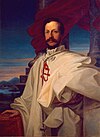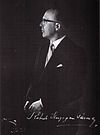House_of_Bourbon-Parma
House of Bourbon-Parma
Cadet branch of the House of Bourbon-Anjou
The House of Bourbon-Parma (Italian: Casa di Borbone di Parma) is a cadet branch of the Spanish royal family, whose members once ruled as King of Etruria and as Duke of Parma and Piacenza, Guastalla, and Lucca. The House descended from the French Capetian dynasty in male line. Its name of Bourbon-Parma comes from the main name (Bourbon) and the other (Parma) from the title of Duke of Parma. The title was held by the Spanish Bourbons, as the founder Philip, Duke of Parma was the great-grandson of Ranuccio II Farnese, Duke of Parma.[2][3] The House of Bourbon-Parma is today the Sovereign House of the Grand Duchy of Luxembourg (agnatically) and all members of the Grand Ducal Family of Luxembourg are members of the House of Bourbon-Parma with the title of "Princes/Princesses" and the predicate of Royal Highness.[4][5][6][7][8][9][10][11][12][13]
This article includes a list of general references, but it lacks sufficient corresponding inline citations. (October 2014) |
| House of Bourbon-Parma | |
|---|---|
 | |
| Parent house | Bourbon-Anjou (agnatic) Farnese (enatic) |
| Country | Former countries |
| Founded | 18 October 1748 |
| Founder | Philip, Duke of Parma |
| Current head | Prince Carlos |
| Final ruler | Guastalla: Ferdinand I (1765–1802) Etruria: Louis II (1803–1807) Lucca: Charles I (1824–1847) Parma: Robert I (1854–1859) |
| Titles | Current:
Former: |
| Deposition |
|
| Website | www.borboneparma.it |

The Duchy of Parma was created in 1545 from that part of the Duchy of Milan south of the Po River, as a fief for Pope Paul III's illegitimate son, Pier Luigi Farnese, centered on the city of Parma. In 1556, the second Duke, Ottavio Farnese, was given the city of Piacenza, becoming thus also Duke of Piacenza, and so the state was thereafter properly known as the Duchies of Parma and Piacenza.
The House of Farnese continued to rule the duchies until 1731 and the death of the last male-line duke, Antonio. Upon his death the duchy passed to Charles of Bourbon, the heir to the duchy through his mother, Elisabeth Farnese. However by the terms of the Treaty of Vienna (1738) Charles had to give up the duchy to Austria.

Temporary Habsburg rule
The Habsburgs only ruled until the conclusion of the Treaty of Aix-la-Chapelle in 1748, when it was ceded back to the Bourbons in the person of Philip of Spain, Charles's younger brother. As Duke Philip, he became the founder of the House of Bourbon-Parma.
In 1796, the duchy was occupied by French troops under Napoleon Bonaparte and absorbed into the Cisalpine Republic and Kingdom of Italy.
In 1814, the duchies were restored under Napoleon's Habsburg wife, Marie Louise, who was to rule them for her lifetime. The duchy was renamed the Duchy of Parma, Piacenza and Guastalla.
Return to the Bourbons
After Marie Louise's death in 1847, the duchy was restored to the Bourbon-Parma line, which had been ruling the tiny Duchy of Lucca. As part of the return, the Duchy of Guastalla was transferred to the Duchy of Modena. The Bourbons ruled until 1859, when they were driven out by a revolution following the Franco-Sardinian victory in their war against Austria.
The duchies of Parma, Piacenza and Guastalla and the Duchy of Lucca joined with the Grand Duchy of Tuscany and the Duchy of Modena to form the United Provinces of Central Italy in December 1859, and were annexed to the Kingdom of Sardinia in March 1860. The House of Bourbon continues to claim the title of Duke of Parma to this day. Carlos-Hugo (Carlist pretender to the Spanish throne in the 1970s) held the title from 1977 to his death. His son now claims the title.
List of dukes
House of Bourbon-Parma (1731–1735)
| Duke | Portrait | Birth | Marriages | Death |
|---|---|---|---|---|
| Charles, Duke of Parma 1731–1735 |  | 20 January 1716 Madrid son of Philip V of Spain and Elizabeth of Parma | Maria Amalia of Saxony 1738 13 children | 14 December 1788 Madrid aged 72 |
House of Bourbon-Parma (1748–1802)
| Duke | Portrait | Birth | Marriages | Death |
|---|---|---|---|---|
| Philip, Duke of Parma 1748–1765 |  | 15 March 1720 Madrid son of Philip V of Spain and Elizabeth of Parma | Louise-Elisabeth de Bourbon 25 October 1739 3 children | 18 July 1765 Alessandria aged 45 |
| Ferdinand I, Duke of Parma 1765–1802 |  | 20 January 1751 Parma son of Philip, Duke of Parma and Louise-Elisabeth de Bourbon | Archduchess Maria Amalia of Austria 19 July 1769 9 children | 9 October 1802 Fontevivo aged 51 |
During the French ownership of the Duchy of Parma, the title of Duke of Parma was used as an honorary form and style. From 1808, the title was used by Jean Jacques Régis de Cambacérès. He kept the style of Duke of Parma until 1814. Only in 1847 was the actual title restored to the Bourbons, after a period of being held by Marie Louise of Austria, who was a Habsburg and the second wife of Napoleon I.
House of Bourbon-Parma (1847–1859)
| Duke | Portrait | Birth | Marriages | Death |
|---|---|---|---|---|
| Charles II, Duke of Parma 1847–1848 |  | 22 December 1799 Madrid son of Louis of Etruria and Maria Louisa, Duchess of Lucca | Maria Teresa of Savoy 5 September 1820 2 children | 16 April 1883 Nice aged 84 |
| Charles III, Duke of Parma 1848–1854 |  | 14 January 1823 Lucca son of Charles II, Duke of Parma and Princess Maria Teresa of Savoy | Princess Louise Marie Thérèse of France 10 November 1845 4 children | 27 March 1854 Parma aged 31 |
| Robert I, Duke of Parma 1854–1859 |  | 9 July 1848 Florence son of Charles III, Duke of Parma and Louise Marie Thérèse of Artois | Maria Pia of the Two Sicilies 5 April 1869 12 children Maria Antonia of Portugal 15 October 1884 12 children | 16 November 1907 Viareggio aged 59 |
Titular Dukes of Parma (since 1859)
- According to the Convention of Fontainebleau.
- French Royal Families. General Books. 2013. ISBN 9781230480824.
- House of Farnese. General Books. 2013. ISBN 9781230551890.
- Marco Matteucci (30 April 2011). La real casa Borbone-Parma dal ducato ad oggi. 150 anni di vicende familiari (in Italian). CLD Libri. ISBN 978-8873991779.
- Gli ultimi Asburgo e gli ultimi Borbone in Italia (in Italian). 1971. p. 140.
"All members of the Grand Ducal Family of Luxembourg, descendants of Grand Duchess Charlotte and Prince Felix, were incorporated into the Bourbon-Parma Family, by grant to Prince Felix from his nephew, Duke Roberto Ugo, in 1964. All members of The Grand Ducal family of Luxembourg have since then been Princes and Princesses of Parma and Piacenza, or of Bourbon-Parma, with the treatment of Royal Highness. The title can be revoked from a descendant of Prince Felix only under the order of the Duke of Parma and Piacenza..." - "Biography of H.R.H. Prince Félix". Cour Grand-Ducale (Official website of the Grand-Ducal Family of Luxembourg).
- "Biography of H.R.H. Prince Louis". Cour Grand-Ducale (Official website of the Grand-Ducal Family of Luxembourg).
- "Biography of H.R.H. Prince Sébastien". Cour Grand-Ducale (Official website of the Grand-Ducal Family of Luxembourg).
- "Biography of H.R.H. the Crown Prince". Cour Grand-Ducale (Official website of the Grand-Ducal Family of Luxembourg).
- "Biography of H.R.H. Princess Alexandra". Cour Grand-Ducale (Official website of the Grand-Ducal Family of Luxembourg).
- "Biography of H.R.H. the Grand Duke". Cour Grand-Ducale (Official website of the Grand-Ducal Family of Luxembourg).
- "Biography of H.R.H. Grand Duke Jean". Cour Grand-Ducale (Official website of the Grand-Ducal Family of Luxembourg).
- "Le solenni esequie di Jean di Lussemburgo". Borboneparma.it (official website of the Parmesan Royal Family) (in Italian).
- Royal and Ducal House of Bourbon-Parma (in Italian)
- Website of the House of Bourbon-Parma (in Italian and Spanish)
- Newspaper clippings about House of Bourbon-Parma in the 20th Century Press Archives of the ZBW






